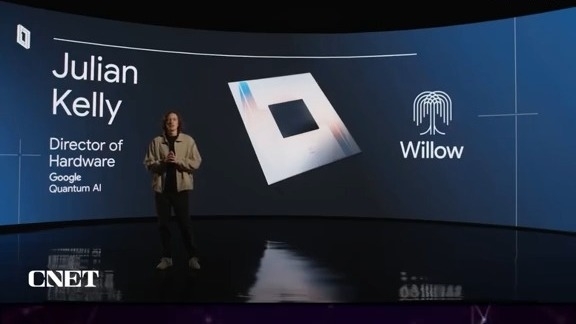Check financial news and trade on East Money Securities one-stop service. On the evening of December 10th, as the U.S. stock market opened, all eyes were on Google. By the close, Google A (GOOGL) had risen by 5.59%, closing at $185.17, nearing its historical closing high of $190.71 set on July 10th. It led the S&P 500 telecommunications sector stocks and achieved the largest single-day gain since April.
Its market value surged by $112 billion overnight (approximately 812 billion yuan). In terms of news, Google announced its new quantum computing chip, Willow, which caused a significant sensation in the global technology community. It is said that this is a major breakthrough in the field of quantum computing – an area seen as the next technological frontier for many tech companies. Google’s press release also stated that Willow can complete a standard benchmark calculation in less than 5 minutes, while the fastest supercomputers today would take ’10 to the power of 25′ years, a figure far exceeding the age of the universe. This achievement was personally announced by Google CEO Pichai on social media and has been urgently published in the scientific journal Nature. The news even drew an exclamation of ‘Wow’ from Elon Musk! Musk responded to Google CEO Sundar Pichai’s tweet with ‘Wow’ – expressing his amazement. Pichai said: One day we should build a quantum cluster in space using Starship. Musk’s reply quickly got him talking, writing, ‘Any civilization with self-respect should at least reach Kardashev Type II civilization. In my view, we are not even 5% of Type I civilization yet.’ Meanwhile, Musk’s ‘old rival,’ the CEO of artificial intelligence company OpenAI, Sam Altman, also forwarded Pichai’s post with ‘big congrats!!’ It’s not easy to receive congratulations from both of them at the same time. Professor Winfried Hensinger from the University of Sussex, an expert in quantum technology, explained that Google’s Willow chip demonstrates a ‘new milestone in how quantum computers handle errors during operations. ‘ ‘As more additional qubits are used to correct these errors, their technology becomes more effective in reducing errors. This is a very important milestone for quantum computers.’ However, Hensinger admitted that Willow, with only 105 qubits, is ‘still too small to perform useful calculations,’ and quantum computers need ‘millions of qubits’ to solve truly significant industry problems.He added, “Building quantum computers with a large number of qubits using superconducting qubits may be fundamentally challenging, as cooling so many qubits to the required temperature – close to absolute zero – is difficult, if not impossible.” Hensinger still agrees that Google’s development has increased interest around quantum computing and its ongoing development, “This outcome further strengthens confidence that humans will be able to create practical quantum computers, enabling some high-impact applications.
” Quantum computers, leveraging the behavior of subatomic particles, require extreme conditions to operate to prevent particle interactions with the surrounding environment. Most experimental assumptions involve temperatures close to absolute zero. Such limitations make it difficult for quantum computing technology to find practical real-world applications, as high error rates hinder the large-scale application of quantum computing. According to a paper published in the scientific journal Nature on Monday, the Willow chip has reduced error rates. This makes it possible to build larger-scale quantum computers, and Google can now begin to weigh cost issues. Various technological approaches are competing for the leading position in the field of quantum computing. Google’s technology, known as superconducting qubits, is also adopted by competitors IBM and Amazon. The manufacturing tools for the Willow chip are similar to those used for traditional microchips. However, Google has recently invested in QuEra Computing Inc, which uses so-called neutral atom qubits. Qubits are the basic unit of information in quantum computing. Analysts say that Willow is epoch-making, and it will be the first step in building useful quantum computing, bringing great potential in many fields such as AI large models, drug discovery, nuclear fusion, and battery design in the future. Experience the new and wonderful investment research assistant immediately. (Source: Daily Economic News)